These pandan recipes invite you on a culinary journey through the versatile uses of the pandan leaf, a tropical plant beloved for its sweet, floral fragrance and vibrant green hue.
Known as the ‘vanilla of the East,’ pandan imparts a unique aroma and flavor to a variety of dishes, elevating them to extraordinary sensory delights.
From traditional Asian desserts to innovative Western adaptations, pandan has found its way into the hearts of gourmets and home cooks alike.
This collection of the 15 best pandan recipes showcases the breadth of pandan’s culinary applications, featuring everything from the soft and chewy Indonesian Klepon to the sophisticated Pandan French Macarons with Coconut Buttercream Filling, and the quick and delightful Pandan Waffles.
Whether you are a seasoned chef or a culinary novice, these recipes offer a gateway to exploring the rich tapestry of flavors and aromas that pandan brings to the table, each dish promising a unique and unforgettable gastronomic experience.
1. Easy 2 Ingredient Pandan Extract
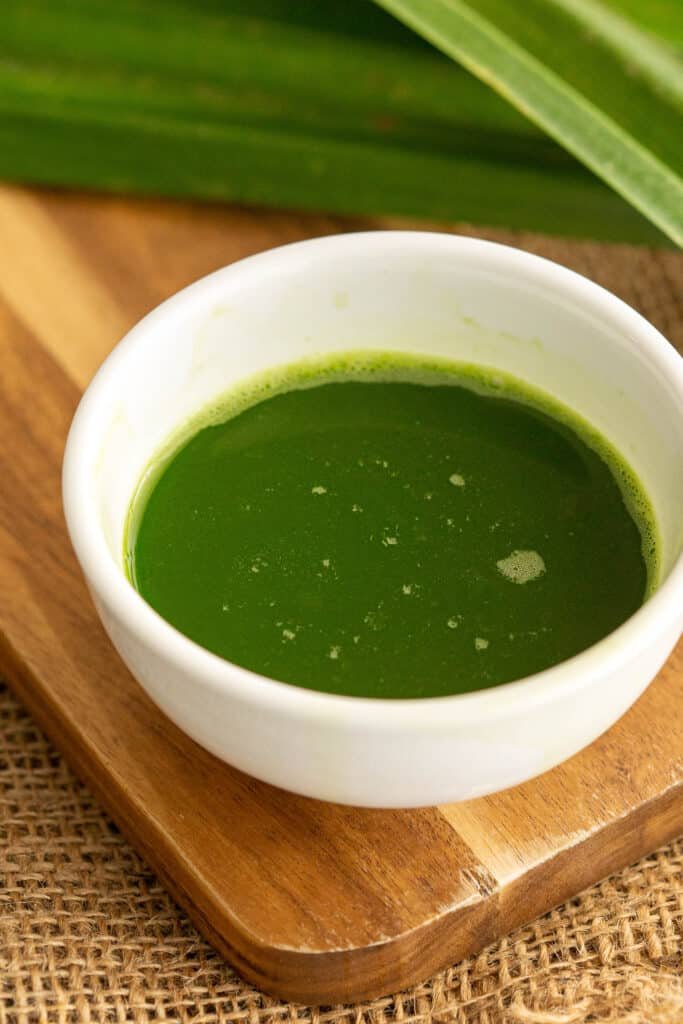
This recipe is a simple and quick way to make Pandan extract, a flavorful and aromatic ingredient common in Indonesian, Malaysian, and Singaporean cuisine.
Pandan extract is derived from pandan leaves and is often used to flavor foods and impart a pleasing aroma. This easy recipe only requires two ingredients and a little bit of time, resulting in approximately 170ml / 5.7oz of fresh pandan extract.
Recommended Equipment:
- Blender or food processor
- Cheesecloth
- Glass jar or bottle for storage
Ingredients:
- 5 pandan leaves fresh or frozen, not dried
- 6 tbsp water
Instructions:
- Clean the Pandan Leaves:
- Wash the pandan leaves under running water to ensure all dirt is removed.
- Preparation of Pandan Leaves:
- Trim off the ends/base of the pandan leaves and discard them.
- Cut the remaining leaves into small pieces, around 2 cm or 1 inch thick, directly into the blender.
- Pour water over the cut leaves in the blender.
- Blending Process:
- Blend the pandan leaves and water until it forms a thick green paste.
- Depending on the blender’s size, you may need to add more water and spoon down the sides to blend the leaves properly.
- Straining Process:
- Lay a square piece of cheesecloth (or a paper towel) over a bowl.
- Spoon the pandan mixture onto the cloth and wrap it up, twisting to hold it together.
- With one hand holding the bundle, use your free hand to squeeze out the juice, repeating if necessary to extract as much juice as possible.
- Storage:
- The extracted pandan juice can be used immediately or poured into a sterilized jar and stored in the fridge.
- If storing, allow it to settle overnight, forming layers with more concentrated pandan extract at the bottom and pandan water on top.
- It is best used fresh within 3 days but can be frozen, albeit with reduced potency, for up to a month in a sealed, airtight container.
Usage Recommendations:
- For baked goods recipes requiring a small amount of pandan paste, use the concentrated pandan extract at a 1:1 ratio to maintain potent flavor without extra water content.
- For recipes involving water, like cooking rice or making sauce, use fresh pandan extract or pandan juice at a 3:1 ratio.
- For lighter flavoring in dishes like rice, you can blend the pulp again with more water, but the extract will be less concentrated.
Tip:
- When choosing pandan leaves, select mature, dark green leaves with minimal blemishes for stronger, more colored extract without needing artificial additives.
This pandan extract can be a delightful addition to various recipes, adding a unique flavor and aroma typical of Southeast Asian cuisine.
2. Pandan Chiffon Cake
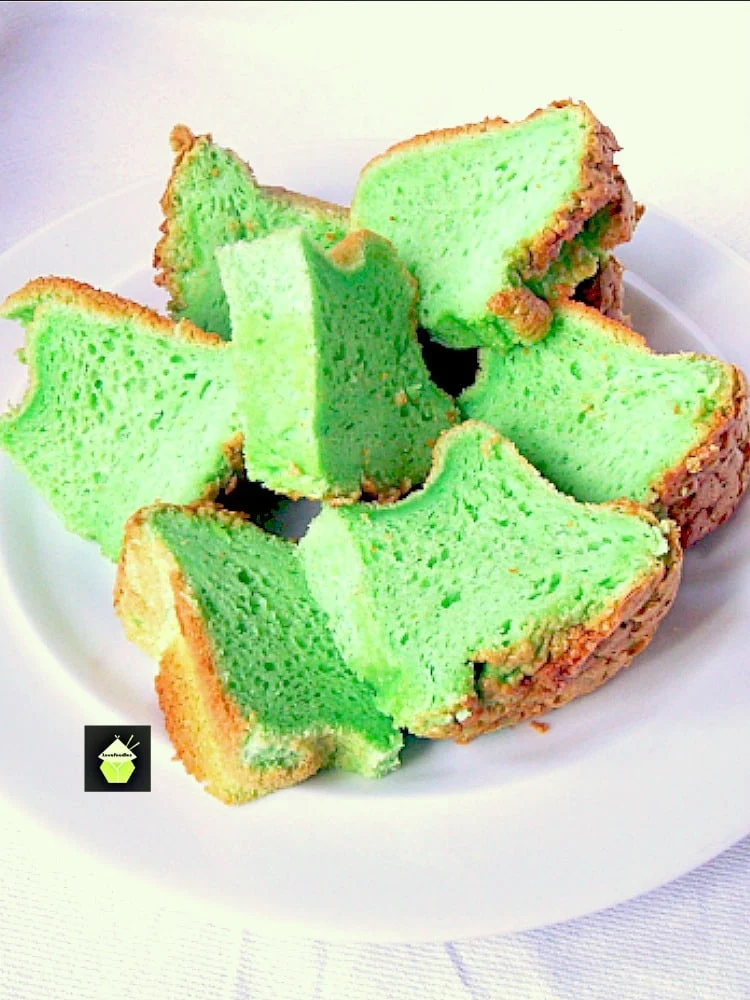
The Pandan Chiffon Cake is a delicate, soft, and fluffy cake characterized by its vibrant green color and unique flavor derived from pandan extract.
This cake is typically associated with Asian cuisine and is renowned for its light texture, and it pairs wonderfully with tea.
This recipe is designed for an 8-serving yield and takes approximately 1 hour and 5 minutes from start to finish, providing easy step-by-step instructions to yield perfect results.
Recommended Equipment:
- Electric mixer
- Baking tin
- Cereal bowl or similar
- Large bowl
- Balloon whisk
- Silicon tin (if available)
- Baking tray
- Skewer
- Wire rack
Ingredients:
- Eggs: 4 whole eggs plus 1 extra egg white. Eggs are primarily used as binding agents in baking, adding structure and stability to the batter.
- Sugar: 135g or ½ cup. It adds sweetness and assists in browning and leavening.
- Vegetable Oil: 90ml or ⅓ cup, used as a fat component, adding moistness to the cake.
- Coconut Milk: 90ml or ⅓ cup, contributing a creamy texture and subtle coconut flavor.
- Pandan Extract: ½ teaspoon, it provides the distinctive flavor and green color to the cake.
- Self Raising Flour: 75g or ½ cup, it’s the foundational ingredient providing structure to the cake. If using plain or all-purpose flour, add ½ teaspoon of Baking powder.
- Cream of Tartar: ½ teaspoon, it stabilizes the egg whites and helps them maintain their whipped texture.
Instructions:
- Preheat the Oven:
- Set the oven to 160°C, Gas 3, or 320°F.
- Do not grease the baking tin.
- Organize Ingredients:
- Prepare the work surface and gather all necessary ingredients and equipment.
- Prepare Eggs:
- Separate the 4 eggs, placing yolks in the mixer bowl and whites in a separate bowl.
- Add one more egg white to the whites’ bowl and discard the yolk.
- Prepare the Batter:
- Combine sugar and vegetable oil with the egg yolks and beat until combined using the electric mixer.
- Incorporate coconut milk and pandan extract and beat again until combined, then switch off the mixer.
- In another large bowl, sieve the self-raising flour (and baking powder if using) from a height and create a well in the center.
- Add the initial mixture to the flour and whisk together using a balloon whisk.
- Prepare the Egg Whites:
- Clean the mixer bowl and beaters as they will be used to whip the egg whites.
- Whip all the egg whites on high speed until foamy, then add cream of tartar and continue to whip until stiff peaks form.
- Combine Ingredients:
- Fold in half of the whipped egg whites into the pandan mixture gently to maintain airiness, followed by the remaining half.
- If using a silicon tin, place it on a baking tray before carefully pouring in the batter.
- Use a skewer to distribute air bubbles by swirling it in the batter.
- Baking:
- Bake in the preheated oven for 45 minutes or until a skewer inserted comes out clean.
- Cooling:
- Once removed from the oven, avoid shaking or bumping the cake.
- Invert the cake in its tin on a wire rack until completely cool to retain fluffiness.
- Once cool, if necessary, run a skewer or spatula around the pan to release the cake.
Serving Suggestions:
Once the cake is completely cool, slice it and serve with a cup of tea for a delightful snack or dessert. The airy and light texture of this Pandan Chiffon Cake, combined with its unique flavor and aroma from the pandan extract, makes it a distinctive and delicious treat to enjoy.
3. Buko Pandan Salad

Buko Pandan Salad is a popular Filipino dessert known for its creamy and delightful flavor, combining young coconut, sweetened condensed milk, and pandan extract for a uniquely tropical experience.
It’s easy to make, ideal for holidays and special occasions, or whenever you crave a sweet, refreshing treat.
The dessert requires a preparation time of 20 minutes and a cook time of 15 minutes, followed by a chilling time of 2 hours, totaling 3 hours to make.
Recommended Equipment:
- Pot
- Large Bowl
- Flat Dish
- Stirring Utensil
Ingredients:
- Green Agar-Agar (2 bars or .70 ounce):
- A vegetarian gelatin substitute derived from seaweed, used to make the gulaman (jelly) in the salad.
- Coconut Juice (3 cups):
- It is used to cook agar-agar, adding a mild coconut flavor to the gulaman.
- Sugar (1 cup):
- It sweetens the gulaman.
- Pandan Extract (4 drops):
- This gives the characteristic flavor and green color to the salad.
- Shredded Young Coconut (2 cups):
- Adds texture and sweetness to the salad.
- Nata de Coco (1 bottle or 12 ounces):
- Sweet, translucent, jelly-like foodstuff produced by the fermentation of coconut water.
- Kaong (1 bottle or 12 ounces):
- Sweet palm fruit adds a chewy texture to the salad.
- Table Cream (1 can or 14 ounces):
- It provides a rich and creamy texture to the salad.
- Sweetened Condensed Milk (1 can or 14 ounces):
- It enhances the creaminess and sweetness of the salad.
Instructions:
- Prepare Agar-Agar:
- Shred the agar-agar bars into small pieces and soak them in coconut juice in a pot for about 30 minutes.
- Bring the mixture to a boil over medium heat and cook while stirring regularly until the agar-agar has melted.
- Sweeten and Flavor Agar-Agar:
- Add sugar to the pot and continue stirring to dissolve.
- Keep cooking for around 10 to 15 minutes or until the agar-agar is completely dissolved.
- Mix in 2 drops of pandan extract for flavor and color, then remove the pot from heat.
- Set Gulaman:
- Pour the mixture into a flat dish and allow it to cool until it’s set and hardened, then cut it into ½-inch cubes.
- Combine Ingredients:
- In a large bowl, combine the cubed gulaman, shredded young coconut, drained nata de coco, drained kaong, table cream, and sweetened condensed milk.
- Final Flavoring:
- Add 2 to 3 more drops of pandan extract to the mixture and stir well to distribute the flavor and color evenly.
- Chill and Serve:
- Refrigerate the salad for about 1 to 2 hours before serving it cold.
Notes:
- If using fresh screwpine or pandan leaves, tie a few strips into a knot and add them while boiling the agar. Remove and discard them once enough flavor and color are extracted.
This Buko Pandan Salad is a festive and visually appealing dessert with its vibrant color and diverse textures, from the chewy gulaman to the creamy mixture, making it a crowd-pleaser for any gathering.
4. Pandan Ice Cream

Pandan Ice Cream is a delightful dessert showcasing the fragrant, sweet, and nutty flavors of pandan leaves, combined with the creamy richness of coconut milk and heavy cream.
Created by Becca Du, this Vietnamese-inspired ice cream recipe is quite straightforward and results in a creamy, flavorful dessert that’s sure to impress. The recipe requires a preparation time of 1 hour, cook time of 15 minutes, and extensive resting time of 8 hours.
Recommended Equipment:
- Candy Thermometer
- Ice Cream Container
- Ice Cream Machine
- Ice Cream Scoop
- Microwave-Safe Bowl
- Sauce Pan
- Whisk
- Fine Mesh Sieve
Ingredients:
- Heavy Cream (1 cup):
- Provides a rich and creamy base for the ice cream.
- Coconut Milk (1 cup):
- Adds a tropical, creamy flavor to the ice cream. Can be substituted with whole milk if needed.
- Pandan Leaves (½ oz or ~2 leaves):
- Gives the ice cream its signature flavor and color.
- Egg Yolks (5):
- Contribute to the creamy texture and rich taste of the ice cream.
- Granulated Sugar (½ cup):
- Sweetens the ice cream.
- Pandan Paste or Extract (1 tsp):
- Enhances the pandan flavor in the ice cream.
- Vanilla Extract (1 tsp):
- Adds a subtle sweetness and aroma to the ice cream.
- Salt (¼ tsp):
- Balances the sweetness of the ice cream.
Instructions:
- Preparation of Cream Mixture:
- Combine heavy cream, coconut milk, and pandan leaves in a microwave-safe bowl and microwave for 1 minute. Allow the pandan leaves to steep in the mixture for an hour to infuse their flavor.
- Mixing Egg Yolks and Sugar:
- In a separate bowl, whisk together egg yolks and granulated sugar until well combined.
- Heating Cream Mixture:
- After steeping, remove the pandan leaves from the cream mixture and heat it in a saucepan until hot (around 3-5 minutes), turning off the heat once the cream is sufficiently hot.
- Combining Egg Yolk Mixture and Cream Mixture:
- Add a portion (1/4 cup) of the hot cream to the egg yolk and sugar mixture, stirring continuously to avoid curdling. Combine this with the remaining hot cream in the saucepan, along with pandan paste, vanilla extract, and salt.
- Cooking Cream Mixture:
- Heat the combined mixture, stirring constantly, until it reaches 140 degrees F, using a candy thermometer to monitor the temperature. The mixture is done when it coats the back of a spoon and retains a trail when finger-swiped.
- Straining and Cooling:
- Strain the mixture through a fine mesh sieve into a bowl to remove any solids, then cool it down completely. Cover and refrigerate for 6-8 hours or preferably overnight for creamier results.
- Churning and Freezing:
- Churn the cooled cream in an ice cream machine for about 10-15 minutes until it reaches the consistency of thick soft-serve. Transfer the churned ice cream to a freezer-safe container and freeze overnight to solidify.
Notes:
- Coconut milk can be substituted with whole milk if unavailable.
- If pandan leaves are not accessible, they can be omitted from the recipe without substitution.
This Pandan Ice Cream, with its distinctive flavor and creamy texture, offers a unique dessert experience, and is a wonderful way to introduce the aromatic and flavorful world of pandan to your culinary repertoire.
5. Thai Pandan Chicken
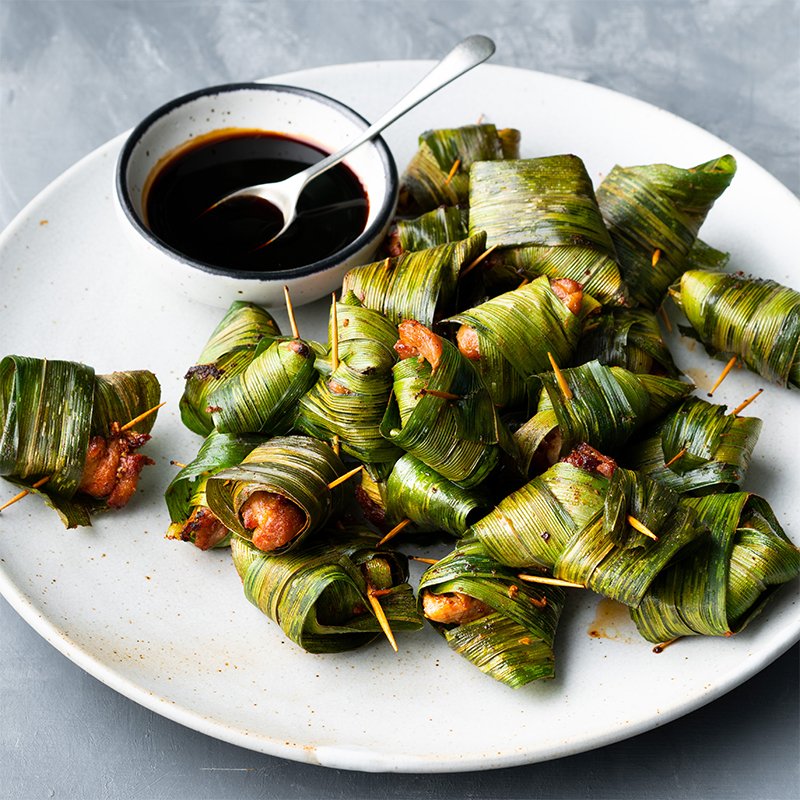
Thai Pandan Chicken is a flavorful and aromatic appetizer where chicken is marinated in a garlicky and peppery sauce, wrapped in fragrant pandan leaves, and deep-fried to golden perfection.
The recipe is simple, requires 10 minutes of preparation and 20 minutes of cooking time, and serves four as an appetizer. The dish is usually accompanied by a sweet and salty dipping sauce, enhancing the overall flavor of the pandan-wrapped chicken.
Recommended Equipment:
- Mortar and Pestle
- Small Saucepan
- Saucepan or Wok for deep frying
- Small serving bowl
- Wooden spoon
Ingredients:
- Chicken (500g or 1 lb):
- Either thigh or breast fillets can be used, cut into 20 bite-sized pieces.
- Pandan Leaves (20 leaves):
- Used to wrap the chicken, adding fragrance and flavor to the dish.
- Toothpicks (20):
- Utilized to secure the pandan leaves around the chicken pieces.
- Vegetable Oil:
- Needed for deep frying the chicken.
For Marinade:
- Garlic Cloves (6):
- Adds a robust and aromatic flavor to the chicken.
- Whole White Peppercorns (1 tsp):
- Offers a mild, complex heat to the marinade.
- Oyster Sauce (3 tbsp):
- Provides a savory, sweet, and salty depth to the marinade.
- White Sugar (½ tsp):
- Balances the savory notes of the marinade.
For Dipping Sauce:
- Soy Sauce (3 tbsp):
- Gives a salty and umami flavor to the sauce.
- Sweet Dark Soy Sauce (2 tbsp):
- Adds sweetness and a dark color to the sauce.
- White Sugar (¼ cup):
- Sweetens the dipping sauce.
- Water (¼ cup):
- Dilutes the sauce to the right consistency.
Instructions:
- Preparing the Marinade:
- Using a mortar and pestle, pound garlic cloves and white peppercorns into a rough paste. Mix this paste with oyster sauce and white sugar to create the marinade. Coat the chicken pieces thoroughly with the marinade, ensuring well combination.
- Wrapping Chicken:
- Wrap each marinated chicken piece with a pandan leaf and secure it with a toothpick. This step can be done a day in advance and refrigerated until ready to cook.
- Preparing the Dipping Sauce:
- In a small saucepan, combine all the ingredients for the dipping sauce and simmer over medium-high heat for about 4-5 minutes or until slightly thickened. Transfer to a serving bowl and allow to cool; it will thicken more as it cools.
- Deep Frying:
- Fill a wok or a saucepan to about 1/3 of its capacity with vegetable oil and heat it over high heat to 165°C/325°F, or until a wooden spoon dipped into the oil forms small bubbles around it.
- Fry the wrapped chicken pieces in batches for 4-5 minutes or until they are dark golden and fully cooked. Drain the fried pieces on paper towels to remove excess oil.
- Serving:
- Serve the pandan chicken hot, accompanied by the prepared dipping sauce.
Notes:
- Fresh pandan leaves are usually available at your local Asian supermarket.
This Thai Pandan Chicken is a delicious and aromatic dish that promises a flavorful journey with each bite, with the savory marinade and the fragrant pandan leaves harmoniously complementing each other. The sweet and salty dipping sauce adds an extra layer of flavor, making it a hit at any gathering.
6. Coconut Pandan Jelly (Thạch Rau Câu Lá Dứa)
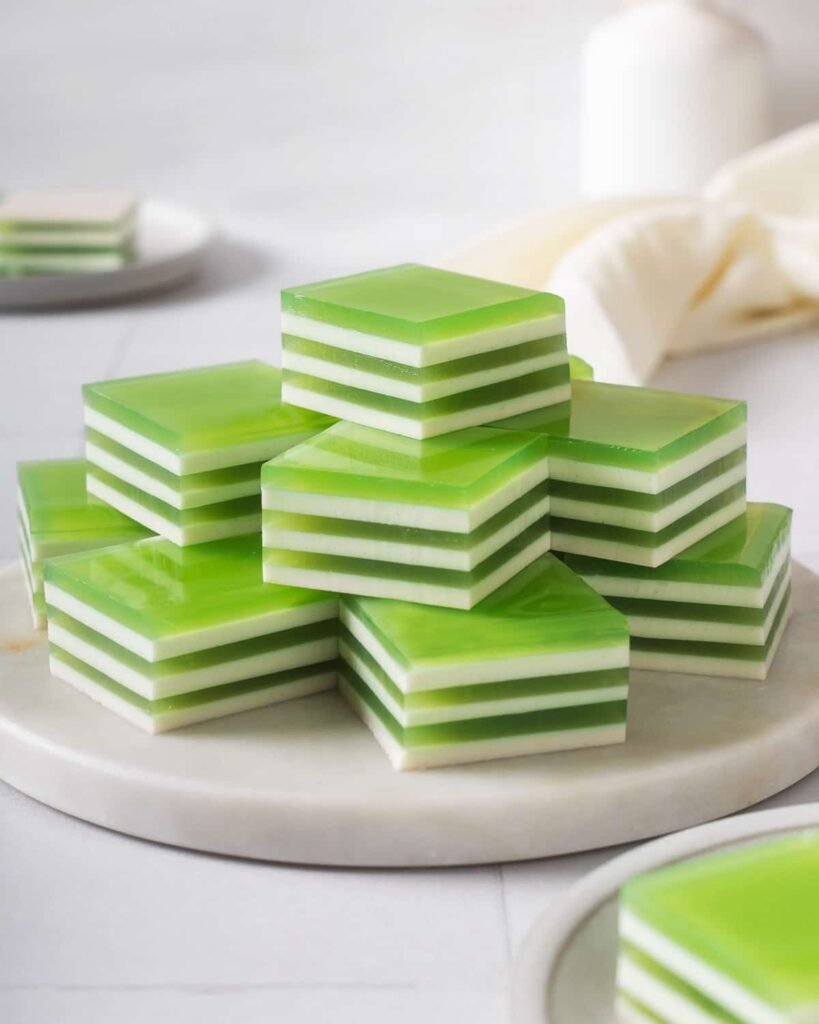
Coconut Pandan Jelly, also known as Thạch Rau Câu Lá Dứa, is a Vietnamese dessert that brings together the tropical, sweet taste of coconut and the unique, aromatic flavor of pandan leaves, resulting in a refreshing and stunning jelly treat.
This layered dessert requires 10 minutes of preparation, 5 minutes of cooking, and 45 minutes of assembling time, serving six people. It is an exemplary sweet treat that is sure to enchant family and friends with its impressive visual appeal and delightful taste.
Recommended Equipment:
- Blender or Food Processor
- Cheesecloth
- Kitchen Scale
- 2 Medium Saucepans
- 1.5 qt Glass Container or Silicone Mold
Ingredients:
For Pandan Layer:
- Pandan Leaves (6), washed and cut into 2-inch pieces:
- These leaves lend a fragrant and unique flavor to the jelly.
- Water (600 ml), divided:
- Needed to extract juice from pandan leaves.
- Granulated Sugar (⅓ cup or 80 g):
- Adds sweetness to the pandan layer.
- Agar Agar Powder (1 tbsp or 8 g):
- A vegetarian gelatin substitute used to set the jelly.
- Pandan Extract (2 drops), optional:
- Enhances the color of the pandan layer.
For Coconut Layer:
- Coconut Milk (1 can or 400 ml), full fat:
- Provides the creamy and tropical flavor to the jelly.
- Water (200 ml):
- To balance the consistency of the coconut layer.
- Agar Agar Powder (1 tbsp or 8 g):
- Used to set the coconut layer.
- Granulated Sugar (½ cup or 100 g):
- Sweetens the coconut layer.
- Salt (⅛ tsp):
- Enhances the flavors of the coconut layer.
- Pandan Leaves (2), washed and knotted:
- Adds fragrance to the coconut layer.
Instructions:
- Prepare Pandan Juice:
- Blend pandan leaves with water until pulverized and extract the juice using a cheesecloth. If needed, adjust the quantity of liquid to make up to 600 ml using additional water.
- Cooking Pandan Layer:
- Transfer pandan juice to a saucepan, add sugar, agar agar powder, and pandan extract. Stir on medium heat until sugar is dissolved and bring to a boil, simmering for 2-3 minutes thereafter.
- Cooking Coconut Layer:
- In another saucepan, combine coconut milk, water, agar agar powder, sugar, salt, and knotted pandan leaf. Bring to a boil, stirring until the sugar is dissolved, and then simmer for 2-3 minutes.
- Layering:
- In a glass container or a mold, carefully layer the pandan mixture first, followed by the coconut mixture, letting each layer set slightly before adding the next one. Repeat until all mixture is used. If the mixture begins to solidify, reheat to liquefy.
- Setting and Serving:
- Once all layers are assembled, refrigerate the jelly for at least 2-4 hours before serving. Run a knife around the edges and flip the mold upside down, slicing the jelly into bite-sized pieces.
Tips and Notes:
- Use freshly washed pandan leaves for a more vibrant and fragrant pandan layer.
- Adjust the sweetness to your liking before pouring the mixtures into the mold.
- Use a kitchen scale or measuring cup to ensure even layers.
- Pour the mixture gently to prevent bubbles and use a toothpick to pop any that form.
- Ensure each layer has set slightly before adding the next one.
- To avoid breaking/melting the previous layer, temper the heat by pouring the hot mixture onto a cold spoon first.
- Store the dessert in an airtight container in the refrigerator for up to 3 days; avoid freezing as it alters the texture upon thawing.
This Coconut Pandan Jelly offers a multi-sensorial delight with its striking layered appearance, its invigorating aroma of pandan leaves, and its pleasant combination of sweetness and creamy texture, making it an enjoyable treat for all occasions.
7. Refreshing Pandan Drink

The Refreshing Pandan Drink is a famous Thai beverage known for its cooling properties, making it a common refresher across Thailand.
It requires only a minimal prep time of 5 minutes and a cook time of 5 minutes, serving four people. This drink is simple and quick to prepare and offers a healthy, revitalizing experience, highlighting the aromatic and flavorful aspects of pandan leaves.
Recommended Equipment:
- Saucepan
- Strainer
- Cutting Knife
- Refrigerator
- Glass or Cup for Serving
Ingredients:
- Pandan Leaves (20):
- These leaves are essential for imparting the unique, aromatic flavor and smell to the drink. Fresh leaves are recommended as they retain more aroma and flavor compared to dried leaves.
- Water (8 cups):
- Serves as the base of the drink.
- Brown Crystalline Sugar (½ cup):
- Adds sweetness to the drink and complements the pandan flavor.
- Ice:
- Essential for serving the drink chilled and enhancing its refreshing quality.
Instructions:
- Preparation of Pandan Leaves:
- Cut the pandan leaves into small sections, each 2-3 inches long, ensuring they are clean and fresh.
- Boiling Pandan Leaves:
- In a saucepan, bring 8 cups of water to a boil and add the cut pandan leaves. Allow the leaves to boil in the water for about 5 minutes to release their flavor and aroma.
- Straining and Sweetening:
- After boiling, strain off the water to remove the pandan leaves and, with the water off the heat, stir in the brown crystalline sugar until fully dissolved. This step is crucial for adding sweetness to the drink and must be done while the water is still hot for the sugar to dissolve properly.
- Cooling and Serving:
- Once the sugar is fully dissolved, allow the drink to cool to room temperature before transferring it to the fridge. When the drink is well-chilled, serve it with plenty of ice for a truly refreshing experience.
Nutritional Information:
- Calories: 100 kcal
- Carbohydrates: 25g
- Sodium: 24mg
- Sugar: 25g
- Calcium: 17mg
- Iron: 1mg
Tips and Notes:
- Fresh pandan leaves are highly recommended for a better aroma and taste, as dried leaves lose most of their smell and flavor through the drying process.
- This drink can be found in good quality Asian markets and sometimes online.
- It is important to serve this drink with enough ice to enhance its refreshing quality.
This Refreshing Pandan Drink, with its unique aroma and sweet flavor from the pandan leaves and brown crystalline sugar, offers a healthy and soothing beverage option, perfect for cooling down on a hot day or relaxing with a flavorful, aromatic drink.
8. Coconut Panna Cotta with Amazing Pandan Flavor
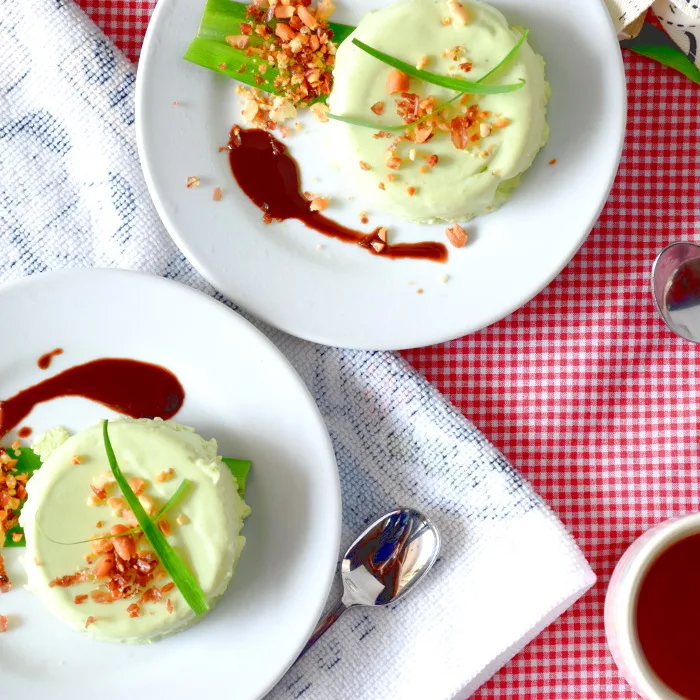
This Coconut Panna Cotta recipe stands out with its incorporation of pandan flavor and coconut milk, bringing a unique and aromatic twist to the traditional Italian dessert.
Yielding 4 small servings, it only requires a prep time of 20 minutes and a cook time of 10 minutes. It’s a creamy, flavorful dessert that is as delightful to the palate as it is visually appealing.
Recommended Equipment:
- Blender
- Small Saucepan
- Strainer
- Ramekins
- Refrigerator
- Serving Plate
Ingredients:
- Gelatin (10g): Acts as a gelling agent to set the panna cotta.
- Milk (30g): Used to dissolve the gelatin.
- Pandan Leaves (15g): Provides a unique flavor and aroma to the panna cotta.
- Coconut Milk (150g): Gives a rich, creamy texture and a distinct coconut flavor to the dessert.
- Milk (120g): Adds creaminess to the mixture.
- Heavy Cream (150g): Enhances the richness and texture of the panna cotta.
- Sugar (40g): Sweetens the dessert.
- Roasted Crushed Groundnuts (40g): Adds a crunchy texture and nutty flavor to the dish when used as a garnish.
- Pandan Leaves: Used for decoration.
- Chocolate Syrup: Adds a sweet and chocolaty flavor when drizzled over the top.
Instructions:
- Preparing Gelatin Mixture:
- Mix together the gelatin and milk (Ingredients A) and set aside for five minutes. Ensure it is stirred gently for even distribution.
- Preparing Pandan-Coconut Mixture:
- Cut pandan leaves into short pieces and blend them with coconut milk. This mixture is crucial for infusing the panna cotta with the pandan flavor and aroma.
- Cooking and Straining:
- In a saucepan, heat up milk, heavy cream, and sugar (Ingredients C) over a small flame, adding the blended pandan leaves and coconut milk. Boil the mixture over medium heat for a minute and then strain to remove the leaves, ensuring a smooth, creamy texture without any lumps or grittiness.
- Combining and Setting:
- Once the strained mixture has cooled to room temperature, combine it with the gelatin mixture (Ingredients A). Lightly oil the surface of the ramekins and fill them with the coconut mixture. Refrigerate the filled ramekins until the dessert has set, which should take a few hours.
- Serving:
- When ready to serve, run a knife along the side of the ramekin, dip the ramekin in hot water for five seconds, then invert and shake the ramekin gently. The panna cotta should detach easily and drop gently onto the serving plate. Finally, decorate with pandan leaves, sprinkle roasted crushed groundnuts, and drizzle chocolate syrup over the top before serving.
Tips and Notes:
- The infusion of pandan leaves and coconut milk must be done carefully to ensure the right balance of flavors.
- It is crucial to strain the mixture thoroughly to achieve a smooth, creamy texture.
- Cooling to room temperature before mixing with the gelatin ensures the mixture sets properly.
- For a flawless presentation, be gentle when inverting the ramekin to ensure the panna cotta maintains its shape.
This Coconut Panna Cotta with Amazing Pandan Flavor is not just a visual treat but also a journey of exquisite flavors and textures, with the aromatic pandan leaves complementing the creamy richness of coconut milk and the crunch of roasted groundnuts adding an exciting contrast.
9. Pandan Rice

Zen offers two simple, fragrant recipes for Pandan Rice – White Pandan Rice and Green Coconut Pandan Rice. Each variant brings forth the subtle aroma of pandan, enveloping the staple long-grain rice with an inviting scent and flavor.
Whether you opt for the mild, elegant white version or the more flavorful, olive-green variant, both are equally enticing. These recipes serve as a versatile base, suitable as a main or side dish in various Southeast Asian meals.
Recommended Equipment:
- Rice Cooker
- Heat-proof Spatula
- Heavy Bottom Pot (as a substitute for a rice cooker)
Ingredients:
- White Pandan Rice:
- Long-grain Rice (1 Cup): Jasmine is recommended but Basmati can also be used.
- Water (1 Cup): Essential for cooking the rice.
- Coconut Cream (3 Tablespoons, Optional): Can be added for richer, creamier rice. This is denser and thicker than coconut milk.
- Green Pandan Rice:
- Long-grain Rice (1 Cup): Jasmine or Basmati rice is suitable.
- Pandan Juice (1 Cup): Provides natural flavor and color; avoid pandan extract as it can make the rice bitter.
- Coconut Cream (3 Tablespoons): Essential for this variant to balance the strong flavor of concentrated pandan.
- Salt (¾ teaspoon): Enhances the overall flavor of the rice.
Instructions:
- Preparation:
- Start by washing the rice thoroughly until the water runs clear to remove excess starch.
- For White Pandan Rice:
- Crush pandan leaves to release their fragrance and tie them into a knot.
- In the rice cooker pot, combine the washed rice, water, and pandan leaves, adding water up to the 1st line on your index finger when held vertically (or follow a 1:1 ratio of rice to water or the markings on your rice cooker).
- Cook the rice and, once done, leave it for an additional 10 minutes before uncovering, allowing all water to be absorbed.
- Remove the pandan leaves and fluff the rice before serving.
- For Green Coconut Pandan Rice:
- Add the washed rice and pandan juice to the pot until the level of the 1st line on your finger.
- Mix in the coconut cream and cook the rice. Once the rice cooker has sounded, leave it for an additional 10 minutes before uncovering. Fluff and serve.
Tips and Additional Notes:
- When measuring water, maintain the ratio and use the same cup to measure both rice and water.
- For stove cooking, you might need a bit more water compared to rice cooker cooking.
- To enhance the fragrance, consider adding other Southeast Asian herbs like ginger, shallots, bruised lemongrass stalks, and garlic.
- Please note that the nutritional information provided is an estimate, and actual values may vary.
These Pandan Rice recipes, with their subtle aroma and versatile nature, can easily elevate any meal, offering a delicious taste of Southeast Asian culinary traditions in the comfort of your own kitchen.
Whether you prefer the delicate simplicity of the White Pandan Rice or the pronounced, rich flavor of the Green Pandan Rice, they promise a satisfying experience.
10. Chicken Wrapped in Pandan Leaves (gai Haw Bai Toey)
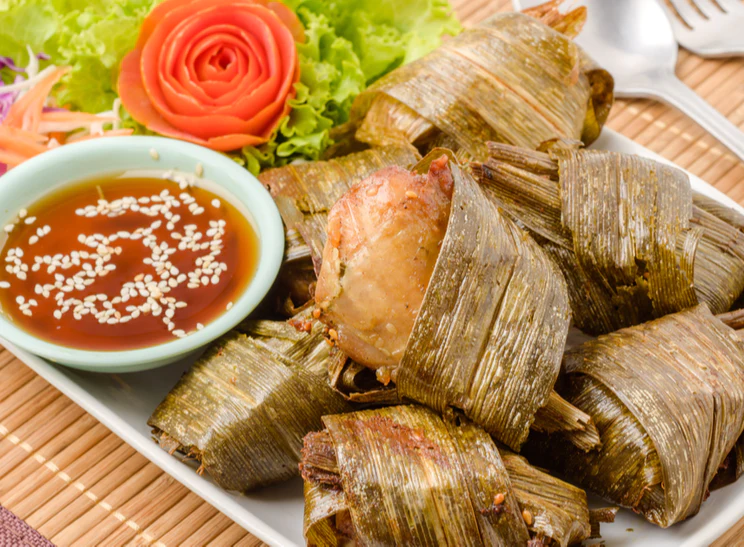
The Chicken Wrapped in Pandan Leaves (Gai Haw Bai Toey) recipe features succulent chicken breast marinated in a blend of aromatic Thai ingredients, enveloped in fragrant pandan leaves, and steamed to perfection.
This dish, redolent with the exotic scents of pandan and spices, offers a taste of authentic Thai cuisine and serves as a delightful appetizer or a main course.
It is known for the aromatic and flavorful experience it brings, with pandan leaves imparting their distinctive taste to the chicken.
Recommended Equipment:
- Steamer
- Pestle and Mortar
- Small Bowl
- Knife
Ingredients:
- Chicken Breast (400g): The main protein source in this recipe.
- Pandan Leaves (200g): Provides a unique flavor and fragrance to the chicken.
- Oyster Sauce (2 tablespoons) and Light Soy Sauce (2 tablespoons): Both add savory and umami flavors to the dish.
- Palm Sugar (2 tablespoons): Adds sweetness to balance the salty and savory flavors.
- Pepper (1 teaspoon): Adds a bit of heat and enhances the overall flavor.
- Sesame Oil (2 tablespoons): Imparts a nutty flavor to the marinated chicken.
- Thai Coriander Root (1 tablespoon) or Coriander Seed (1 tablespoon): Adds a fresh, citrusy flavor.
- Minced Thai Garlic (1 tablespoon): Enhances the flavor profile with its pungent, spicy taste.
Instructions:
- Preparation:
- Start by cleaning the pandan leaves, removing any roots, and letting them dry.
- In the meantime, use a pestle and mortar to create a fine paste by pounding Thai garlic, pepper, and Thai coriander root.
- Marinating:
- Dice the chicken breast into small pieces and mix with the prepared paste, light soy sauce, oyster sauce, and sesame oil.
- Allow the chicken to marinate for a couple of hours to absorb the flavors.
- Wrapping and Steaming:
- After marination, wrap each piece of chicken with pandan leaves, ensuring the chicken is entirely enveloped.
- Place the wrapped chicken in a steamer and steam them over boiling water for approximately 10 minutes.
- Dipping Sauce:
- While the chicken is steaming, prepare the dipping sauce by mixing sugar, soy sauce, water, and salt in a small bowl until the sugar has dissolved. Optionally, add toasted sesame seeds for additional flavor and texture.
- Final Cooking Step:
- After steaming, cook the pandan-wrapped chicken in oil over medium heat until fully cooked and aromatic.
Tips and Additional Notes:
- Ensure that the chicken is well wrapped in the pandan leaves to allow the flavors to infuse properly during cooking.
- Adjust the amount of soy sauce, sugar, and salt in the dipping sauce according to your taste preferences.
- Serving the chicken warm will enhance the aroma and flavor of the pandan leaves, making the dish more enjoyable.
This recipe provides a harmonious blend of flavors and aromas, with the pandan leaves enhancing the marinated chicken’s taste profile. It is a delightful representation of Thai culinary arts, suitable for those eager to explore diverse and exotic culinary experiences.
11. Spiral pandan mantou
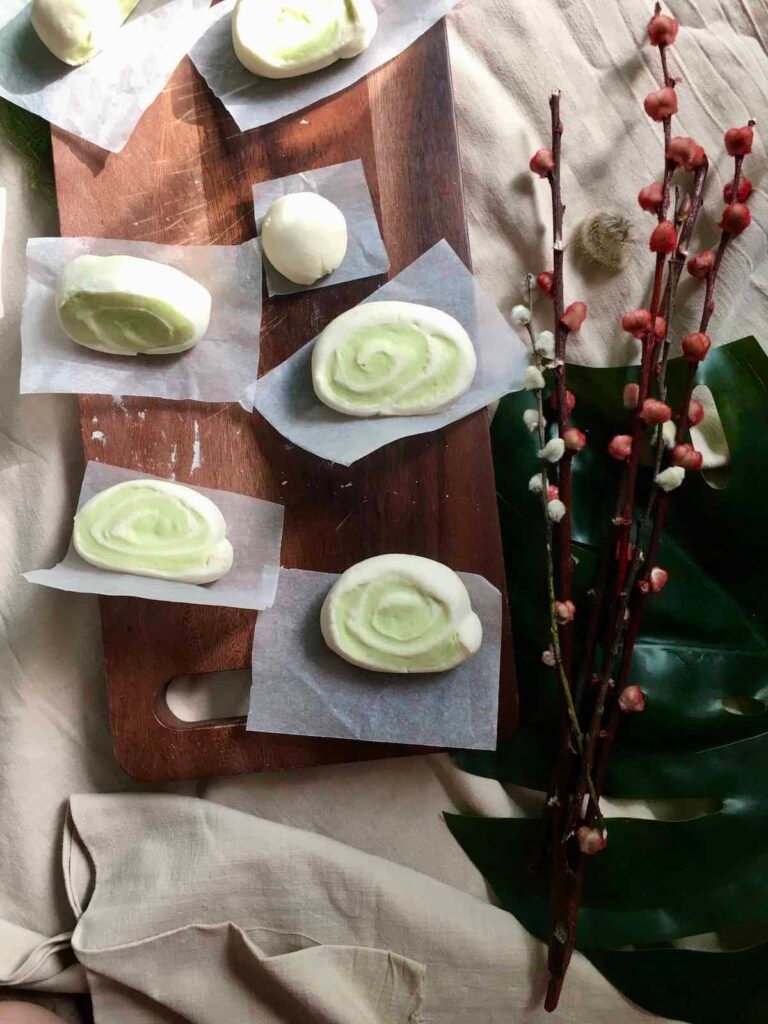
Spiral Pandan Mantou is a visually striking and flavorful Steamed Chinese Bun, combining traditional mantou dough with the aromatic taste of pandan, a common ingredient in Southeast Asian cuisine.
This recipe, with its soft, fluffy texture and unique spiral design, offers a versatile dish that can be enjoyed as a breakfast item, a snack, or a side dish. It exemplifies a harmonious blend of simplicity and flavor, with the pandan adding a delicate, sweet fragrance and a vibrant green hue to the buns.
Recommended Equipment:
- Stand Mixer with Dough Hook
- Bamboo Steamer (or a metal steamer with a cloth to wrap the lid if bamboo is unavailable)
- Rolling Pin
- Parchment Paper or Silpat
Ingredients:
- For White Mantou Dough:
- Hong Kong Flour (250g): A high-quality flour; can substitute with all-purpose flour or cake flour.
- White Sugar (1 tablespoon): Adjust to taste; use vegan sugar for a vegan variant.
- Instant Yeast (1 teaspoon): Essential for fermentation and rising of the dough.
- Baking Powder (¾ teaspoon): Acts as a leavening agent.
- Warm Water (125-140g): Can substitute with milk or soy milk.
- For Green Pandan Mantou Dough:
- All-Purpose Flour (250g): Since the dough is colored, high-quality flour is not necessary.
- Pandan Juice (125-140g): Adds flavor and color; homemade is recommended.
- Other ingredients are the same as the white mantou dough.
- Oil (Optional): To oil the metal steamer if you don’t have parchment paper or cupcake wrappers.
Instructions:
- Preparation:
- Fill the steamer with tap water.
- Make white mantou dough first to avoid color contamination. Mix the dry ingredients well, then add water and knead using a stand mixer on low for approximately 8 minutes. Add more water if necessary, a teaspoon at a time.
- Dough Resting:
- Once the white dough is smooth and non-sticky, form it into a ball, cover it, and refrigerate it.
- Repeat the above steps for green pandan dough.
- Rolling and Layering:
- Roll out both doughs separately on well-floured surfaces into thin rectangles. Then layer the green dough on top of the white dough and lightly roll them together.
- Forming the Spirals:
- Roll the layered doughs into a log, like a Swiss roll, starting from the less straight edge.
- Cut the long log into 16 pieces, placing each on a piece of parchment paper or a cupcake wrapper.
- Steaming:
- Place the mantous into the steamer, ensuring there is at least 1.5 inches between each to prevent sticking.
- Allow to rest for 20-30 minutes depending on the weather until they have increased about 40-50% in size and are very smooth.
- Once the water is at a rolling boil, reduce the heat to medium-low and steam the mantous for 10 minutes.
Tips and Additional Notes:
- The mantous are best enjoyed warm, and adjusting sugar in the dough to taste is advisable.
- If all mantous cannot be steamed in one go, store the remaining in the fridge to prevent overproofing, especially in warm weather.
- For a green exterior on the mantou buns, place the green dough underneath the white dough during the layering process.
- Pay close attention to the dough’s hydration levels, adjusting water as needed to achieve a smooth, non-sticky dough.
This recipe, rich in flavor and aesthetic appeal, offers a glimpse into the culinary diversity of Southeast Asian and Chinese cuisines.
12. Singapore kueh dadar pandan coconut pancake recipe (Vegan)

This recipe brings to life the renowned Singapore Kueh Dadar, a deliciously flavored pandan coconut pancake originating from Southeast Asian, predominantly Singaporean, Nyonya, and Peranakan cuisines. This vegan adaptation is particularly convenient for those unable to access freshly grated coconut and avoids the use of eggs.
Recommended Equipment:
- Pestle and Mortar (or Grater)
- Spice Grinder (or an additional Pestle and Mortar)
- Deep Pot
- Whisk
- Sieve
- Heavy Flat-bottomed Non-stick Pan or Crepe Pan
- Ladle
- Kitchen Towel
- Parchment Paper Lined Baking Tray
Ingredients:
For the Filling:
- 250g Desiccated Coconut: Soaked in 75g of coconut milk for rehydration. Alternatively, use 250g of freshly grated coconut if available.
- 75g Coconut Milk: Ensure it’s not coconut cream. If using coconut cream, mix it with water in a 2:1 ratio.
- 100g Gula Melaka (Palm Sugar): This can be grated or pounded into chunks for easy dissolution.
- ⅓ Cup Water (or 79g)
- Pandan Leaves: A few, bruised and knotted; these are optional but recommended for authentic flavor.
- ½ Teaspoon Salt
For the Pandan Crepe:
- 2 Tablespoons Flax Seed Powder: Mix with water to create a flax egg as a vegan alternative to eggs.
- 6 Tablespoons Water: For the flax egg.
- 2½ Cups Flour (300g): Hong Kong or all-purpose flour.
- 1 Tablespoon Tapioca Flour
- 2⅓ Cup Pandan Juice (550ml)
- 100 ml Coconut Milk: See above for instructions if only coconut cream is available.
- ¼ Teaspoon Salt
- Neutral Vegetable Oil: A few tablespoons, for greasing the pan.
Instructions:
- Prepare Flax Egg: Mix the flax seed powder with water and leave it for 15 minutes to create a flax egg.
- Prepare the Batter: Sift together the flours and salt, then gradually mix them with the pandan juice and coconut milk until smooth, avoiding lump formation. Add the prepared flax egg and whisk well, then rest the mixture in the fridge for 30-60 minutes.
- Prepare the Filling: Rehydrate desiccated coconut with coconut milk and prepare the gula melaka by grating or pounding. Boil the gula melaka with water, salt, and optional pandan leaves, then add the rehydrated coconut and simmer until it reaches the desired consistency. Cool before using.
- Cook the Crepes: Sieve the rested batter to remove any lumps, then cook thin crepes in a well-heated and oiled pan, about 2 minutes on the first side and 30 seconds on the other. Lay them on parchment paper to avoid sticking.
- Assemble the Pancakes: Once both the crepes and filling are cooled, place some filling in the center of each crepe, fold the edges, and roll them up to form cylindrical-shaped snacks.
Note:
- Avoid storing these pancakes overnight, especially when using freshly grated coconut, as it spoils quickly.
- This dish is not only visually appealing with its vibrant green hue but is also rich in flavor and texture, providing a sweet and savory culinary experience.
13. Pandan kelepon (Ondeh Ondeh) recipe
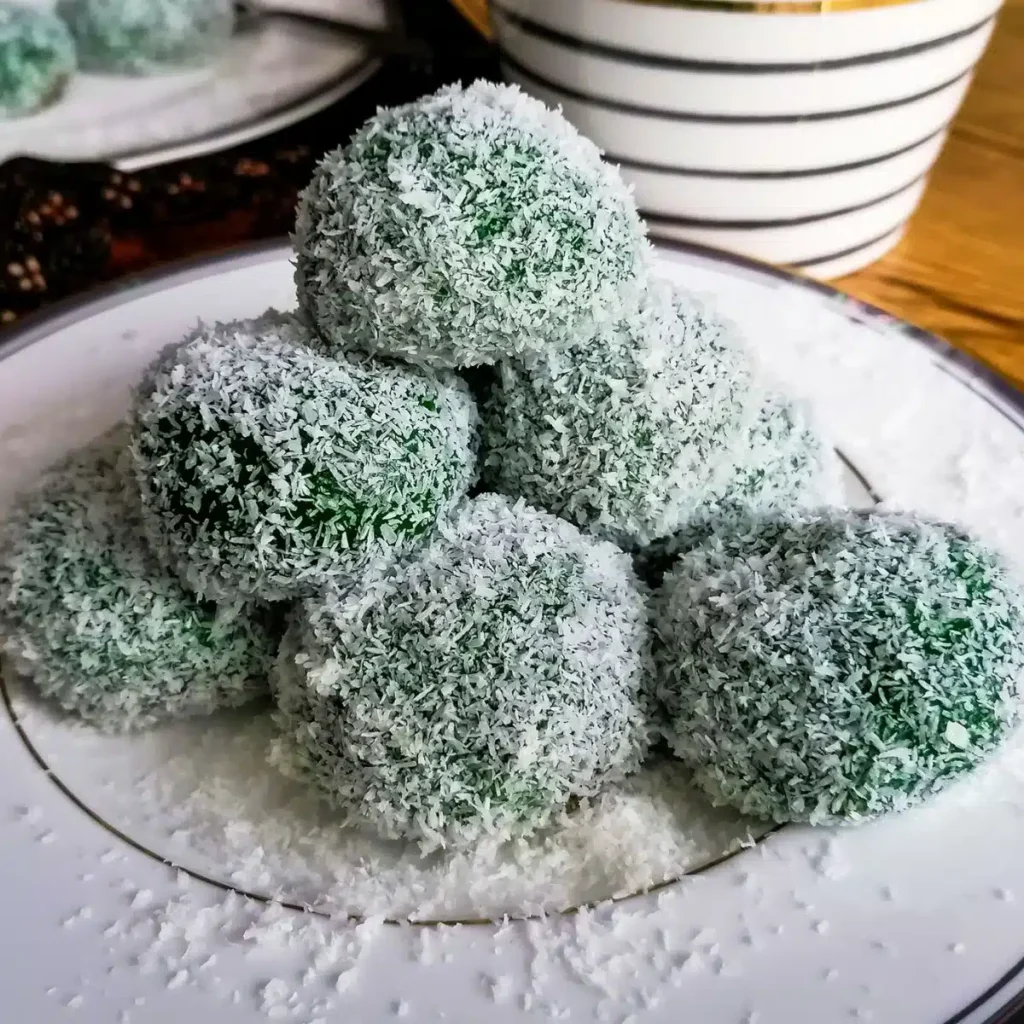
Klepon, also known as Ondeh Ondeh or Pandan Kelepon, is a cherished sweet snack and dessert originating from Indonesia. It consists of small, soft, and chewy balls made from glutinous rice flour, often enjoyed with a cup of tea in the afternoon.
These delightful sweet treats have a brown sugar filling and are coated with coconut, offering a blend of textures and flavors in every bite. This specific recipe by Devy is an uncomplicated approach to making this traditional snack and will yield 5 servings.
Recommended Equipment:
- Mixing Bowls
- Cooking Pan
- Slotted Spoon
Ingredients:
- 2 cups Glutinous Rice Flour (or Sweet Rice Flour)
- This forms the base of the klepon and gives it its characteristic chewiness.
- 5 tablespoons Rice Flour
- This helps in giving the right texture to the klepon.
- ½ teaspoon Salt
- Balances the sweetness of the palm sugar.
- 3 teaspoons Slaked Lime Water
- Acts as a conditioner and contributes to the softness of the dough.
- 2 teaspoons Pandan Extract
- Provides the distinct, sweet, and fragrant flavor typical of klepon.
- 1 cup Water
- Needed to form a pliable dough.
- ⅓ cup Palm Sugar (or Dark Brown Sugar)
- Offers a rich, deep sweetness and serves as the filling.
- ½ cup Desiccated Coconut
- Provides a flavorful coating to the balls, enhancing both taste and texture.
Instructions:
- Prepare the Dough:
- In a mixing bowl, combine glutinous rice flour, rice flour, and salt, mixing well.
- Incorporate the slaked lime water and additional water, ensuring to mix and knead well until a pliable dough is formed. If the dough is too dry, add water sparingly, one or two teaspoons at a time, making sure to knead well between additions to avoid oversaturation.
- Forming the Klepon Balls:
- Grease your hands with a little oil to prevent sticking and take a tablespoon of dough, shaping it into a small ball.
- Flatten the ball to about 0.5 cm/0.2 inch thick, and place a teaspoon of sugar in the center. Enclose the sugar with the dough edges and reshape into a ball.
- Cooking the Balls:
- Bring about 1 litre/35.2 fl.oz of water to a boil in a cooking pot.
- Carefully place the klepon balls in the boiling water and gently stir to prevent them from sticking to the pot’s bottom.
- Once the balls float to the water’s surface, allow them to cook for an additional two minutes.
- Use a slotted spoon to remove the balls, draining all the water, and place them on an oil-greased plate until cool enough to handle.
- Final Touch:
- Once cooled, roll the klepon balls in the desiccated coconut to coat them thoroughly.
Notes:
- To facilitate the shaping process, grease your hands and the plate with a little oil.
- Enjoying them fresh is recommended, as the textural integrity is best shortly after they’re made.
Nutritional Information:
Each serving provides approximately 88 kcal, 17g of carbohydrates, 1g of protein, 2g of fats, and 2g of sugar. The recipe is relatively low in sodium, potassium, and provides trace amounts of calcium, iron, and Vitamin C.
This traditional Indonesian dessert is not only a treat to the taste buds with its multifaceted flavor profile but is also visually appealing, and its delightful texture makes it a favorite among both adults and children.
14. Pandan-flavoured French Macarons

Pandan flavored French macarons are delicate and delectable treats, characterized by their sweet and aromatic pandan essence, paired with a creamy coconut buttercream filling.
This unique flavor combination brings an enticing tropical twist to the classic French dessert. This particular recipe, garnering a high rating of 5 from 3 votes, yields macarons that are not only delicious but also visually appealing with a vibrant green hue.
Recommended Equipment:
- Large Mixing Bowls
- Whisk
- Mixer
- Rubber Spatula
- Piping Bag
- Baking Sheet
- Parchment Paper
- Cooling Rack
Ingredients:
For the Macarons:
- ¾ cup Almond Flour:
- This acts as the base of the macarons and provides a nutty flavor.
- 1 cup Confectioner’s Sugar:
- This provides sweetness and assists in achieving the desired texture of the macarons.
- 2 Egg Whites (Room Temperature):
- Acts as a leavening agent, providing structure and stability to the macarons.
- 1/8 cup Granulated Sugar:
- This helps in stabilizing the egg whites during the whipping process.
- ½ tsp Pandan Extract:
- Gives the macarons their characteristic pandan flavor and aroma.
- ½ tsp Green Food Coloring:
- Provides the vibrant green color associated with pandan flavor.
For the Coconut Buttercream Filling:
- 8 tbsp Coconut Milk:
- Adds a creamy, coconut flavor to the buttercream filling.
- ¾ cup Unsalted Butter:
- Creates a creamy texture for the buttercream filling.
- 1 cup Confectioner’s Sugar:
- Sweetens the buttercream filling and enhances its texture.
Instructions:
Preparing the Macarons:
- Mix Dry Ingredients:
- Sift almond flour and confectioner’s sugar into a large mixing bowl.
- Mix them using a whisk and set aside.
- Prepare Egg Whites:
- In another large bowl, beat the egg whites using a mixer until they are foamy.
- Gradually add the granulated sugar and continue to mix on high speed until soft peaks form.
- Combine Mixtures:
- Gently fold half of the egg white mixture into the almond flour mixture using a rubber spatula until well incorporated.
- Add the remaining egg white mixture and fold until fully combined.
- Add pandan extract and green food coloring and fold gently until the batter is uniform in color and consistency.
- Piping and Resting:
- Using a piping bag, pipe the batter onto a parchment-lined baking sheet, forming circles about 1.5-2 inches in diameter.
- Tap the baking sheet on the countertop several times to remove any air bubbles and let the piped batter rest at room temperature for at least 30 minutes or until the batter does not stick to the finger when touched.
Baking:
- Preheat the Oven:
- Preheat the oven to 300 degrees Fahrenheit.
- Baking Process:
- Bake the macarons for approximately 14-15 minutes, depending on their size.
- Once done, remove them from the oven and the baking sheet and let them cool on a cooling rack.
Preparing the Coconut Buttercream Filling:
- Mixing:
- In a bowl, combine coconut milk, unsalted butter, and confectioner’s sugar.
- Use a mixer to blend the ingredients until they are well incorporated and the mixture is creamy.
Assembling the Macarons:
- Filling the Macarons:
- Using a piping bag, pipe the coconut buttercream on one macaron cookie.
- Pair it with another similarly sized macaron cookie, forming a sandwich.
Tips:
- Ensure all the utensils used for beating the egg whites are free from any oil or grease.
- It is crucial to let the piped macarons rest before baking to form a smooth, shiny crust and to achieve the distinctive “feet.”
With their sweet, fragrant, and tropical flavor, these pandan flavored French macarons are a delightful and visually striking twist on the classic version, sure to impress at any gathering.
15. Pandan waffles
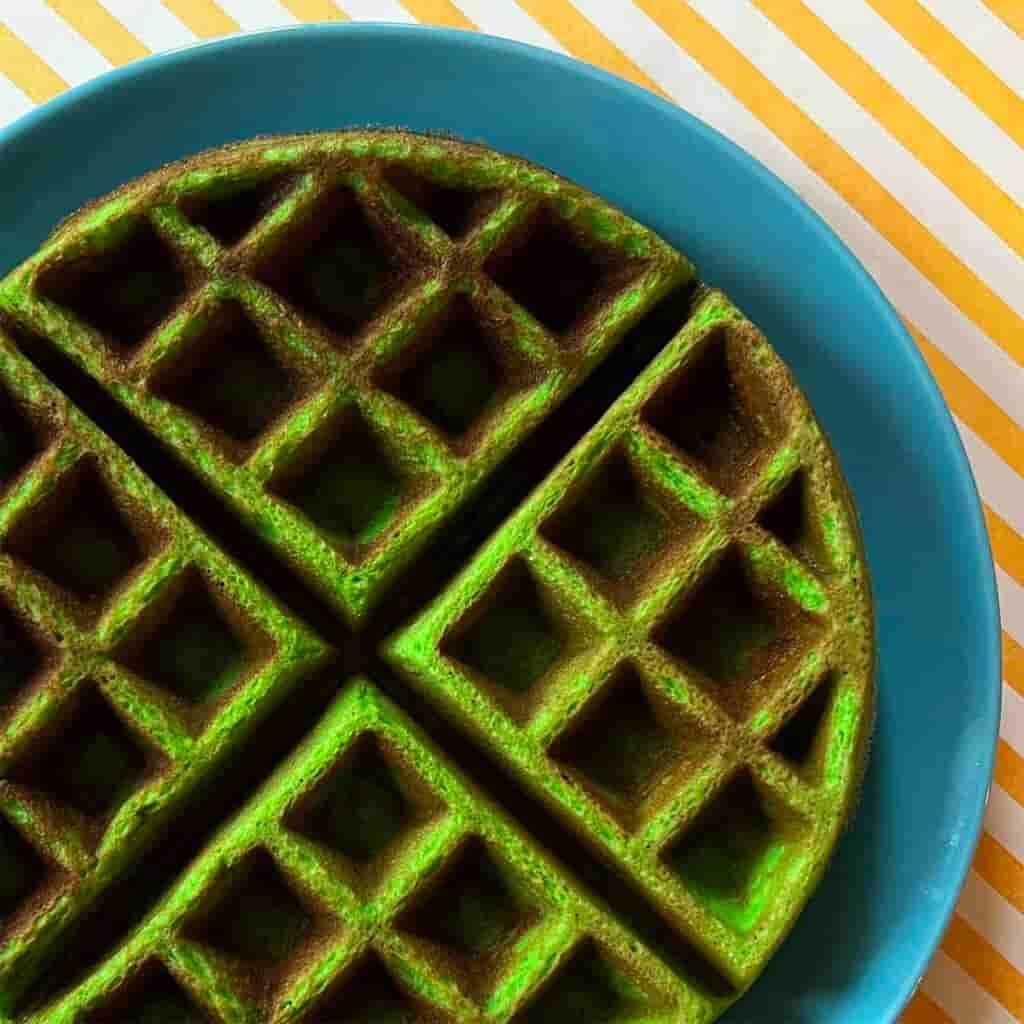
Quick Pandan Waffles, also known as Bánh Kẹp Lá Dứa, are a delightful and easy-to-make Vietnamese dessert characterized by the aromatic and flavorful pandan essence.
This gluten-free dessert, authored by Emily Krill, promises a flavorful escape to tropical bliss, requiring merely 8 minutes from start to finish. This recipe yields two standard-sized waffles or one Belgian-sized waffle, a perfect and quick solution to satisfy those sweet tooth cravings.
Recommended Equipment:
- Waffle Iron (Standard or Belgian-sized)
- Blender
- Rubber Spatula
- Cooking Spray
Ingredients:
- 1 teaspoon Pandan Extract:
- It imparts the unique and aromatic flavor characteristic of pandan waffles.
- 3 Large Eggs:
- These act as a binding agent and contribute to the structure of the waffles.
- 1 tablespoon Vegetable Oil or Melted Coconut Oil:
- This adds moisture to the batter and prevents the waffles from drying out.
- ¼ cup Coconut Flour or All-Purpose Flour:
- This acts as the base and structure of the waffle. Coconut flour will keep the recipe gluten-free.
- 2oz Cream Cheese:
- It adds a creamy texture and rich flavor to the waffles.
- 2 tablespoons Sugar or Swerve Granular:
- This adds sweetness to the waffles. Swerve Granular is a sugar substitute suitable for a low-carb diet.
- ¾ teaspoon Baking Powder:
- This acts as a leavening agent, helping the waffles to rise and become fluffy.
- Cooking Spray:
- It is used to grease the waffle iron, ensuring easy removal of the waffles.
Instructions:
- Preheat and Prep Waffle Iron:
- Preheat either a standard or Belgian-sized waffle iron according to the manufacturer’s instructions.
- Once heated, spray it with cooking spray to prevent the batter from sticking.
- Blend Ingredients:
- Add all the listed ingredients to a blender.
- Blend the ingredients for 30 seconds. After the initial blend, use a rubber spatula to scrape down the sides of the blender to ensure all ingredients are well-incorporated, and then blend for another 30 seconds.
- Cooking the Waffle:
- Pour the blended batter onto the preheated and greased waffle iron, ensuring the wells are adequately covered with the batter.
- Close the lid of the waffle maker and cook according to the manufacturer’s instructions, typically around 3-4 minutes or until the waffles attain a golden brown color.
Tips:
- Make sure to preheat the waffle iron properly, as adding batter to a not adequately heated iron can result in uneven cooking.
- Adjust the sweetness level according to preference, especially if opting for sugar substitutes.
Jenny has always been passionate about cooking, and she uses her platform to share her joy of food with others. Her recipes are easy to follow, and she loves giving tips and tricks to help others create their own unique culinary creations.

